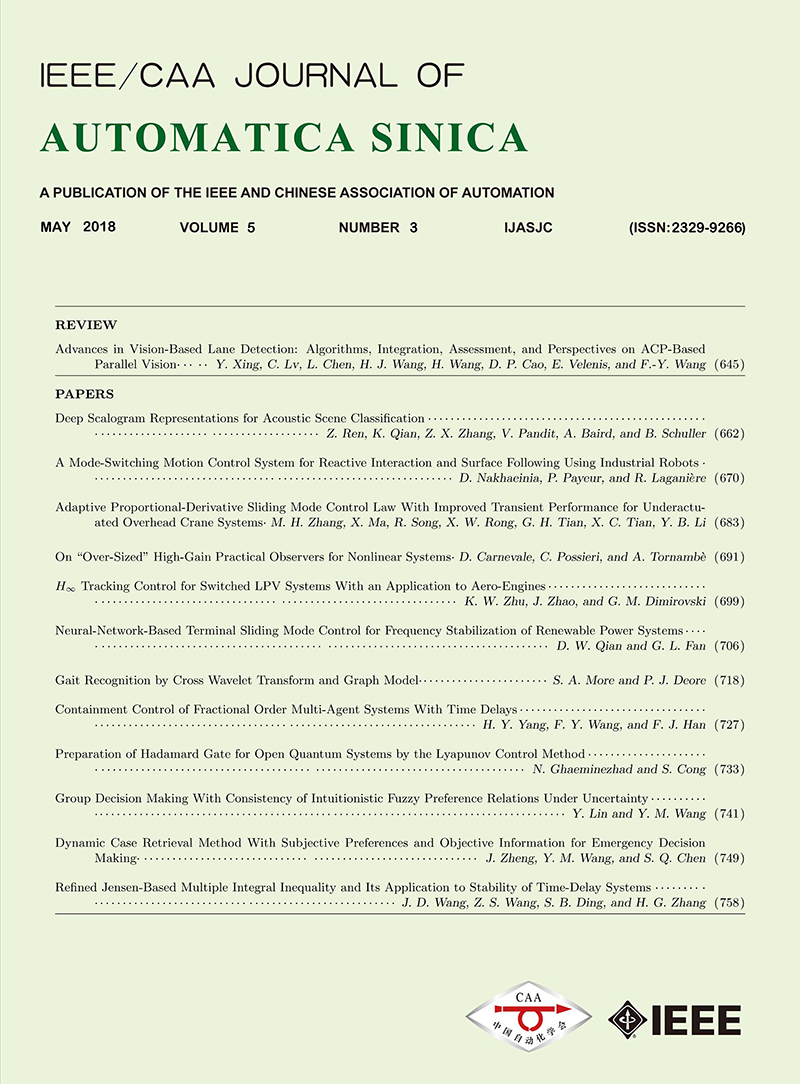 Volume 1
Issue 1
Volume 1
Issue 1
IEEE/CAA Journal of Automatica Sinica
| Citation: | Nan Xiao, Xuehe Wang, Lihua Xie, Tichakorn Wongpiromsarn, Emilio Frazzoli and Daniela Rus, "Road Pricing Design Based on Game Theory and Multi-agent Consensus," IEEE/CAA J. of Autom. Sinica, vol. 1, no. 1, pp. 31-39, 2014. |

| [1] |
Deakin E, Harvey G, Pozdena R, Yarema G. Transportation Pricing Strategies for California:An Assessment of Congestion, Emissions, Energy, and Equity Impacts, Technical Report, UCTC, No.434, Transportation Center, University of California, USA, 1996
|
| [2] |
Menon A. ERP in Singapore:a perspective one year on. Traffic Engineering and Control, 2000, 41(2):40-45
|
| [3] |
Olszewski P, Xie L T. Modelling the effects of road pricing on traffic in Singapore. Transportation Research Part A:Policy and Practice, 2005, 39(7-9):755-772
|
| [4] |
Tsekeris T, Voβ S. Design and evaluation of road pricing:state-of-the-art and methodological advances. Netnomics, 2009, 10(1):5-52
|
| [5] |
Button K J, Verhoef E T. Road Pricing, Traffic Congestion and the Environment:Issues of Efficiency and Social Feasibility. Cheltenham, UK, and Northampton, MA:Edward Elgar Publishing, 1998
|
| [6] |
Gibbons R. A Primer in Game Theory. New York:FT Prentice Hall, 1992
|
| [7] |
Basar T, Olsder G J. Dynamic Noncooperative Game Theory (Second edition). Philadelphia:Society for Industrial and Applied Mathematics, 1999
|
| [8] |
Fudenberg D, Levine D. The Theory of Learning in Games. New York:MIT Press, 1998
|
| [9] |
Shapley L. Some topics in two-person games. Advances in Game Theory, 1964, 52:1-29
|
| [10] |
Jordan J S. Three problems in learning mixed-strategy Nash equilibria. Games and Economic Behavior, 1993, 5(3):368-386
|
| [11] |
Shamma J S, Arslan G. Unified convergence proofs of continuous-time fictitious play. IEEE Transactions on Automatic Control, 2004, 49(7):1137-1142
|
| [12] |
Monderer D, Shapley L. Potential games. Games and Economic Behavior, 1996, 14(1):124-143
|
| [13] |
Marden J, Arslan G, Shamma J. Joint strategy fictitious play with inertia for potential games. IEEE Transactions on Automatic Control, 2009, 54(2):208-220
|
| [14] |
Olfati-Saber R, Fax J A, Murray R M. Consensus and cooperation in networked multi-agent systems. Proceedings of the IEEE, 2007, 95(1):215-233
|
| [15] |
Tahbaz-Salehi A, Jadbabaie A. A necessary and sufficient condition for consensus over random networks. IEEE Transactions on Automatic Control, 2008, 53(3):791-795
|
| [16] |
Qu Z H. Cooperative Control of Dynamical Systems. New York:Springer, 2009
|
| [17] |
Kingston D B, Beard R W. Discrete-time average-consensus under switching network topologies. In:Proceedings of the 2006 American Control Conference. Minneapolis, MN:IEEE, 2006. 3551-3556
|
| [18] |
Ren W, Beard R W. Distributed Consensus in Multi-Vehicle Cooperative Control:Theory and Applications. New York:Springer, 2008
|
| [19] |
Cao M, Morse A S, Anderson B D. Reaching a consensus in a dynamically changing environment:a graphical approach. SIAM Journal on Control and Optimization, 2008, 47(2):575-600
|
| [20] |
Cao M, Morse A S, Anderson B D. Reaching a consensus in a dynamically changing environment:convergence rates, measurement delays, and asynchronous events. SIAM Journal on Control and Optimization, 2008, 47(2):601-623
|
| [21] |
Bauso D, Giarré L, Pesenti R. Consensus in noncooperative dynamic games:a multiretailer inventory application. IEEE Transactions on Automatic Control, 2008, 53(4):998-1003
|
| [22] |
Bauso D, Giarré L, Pesenti R. Distributed consensus in noncooperative inventory games. European Journal of Operational Research, 2009, 192(3):866-878
|
| [23] |
Patriksson M. The Traffic Assignment Problem:Models and Methods. Utrecht:VSP, 1994
|
| [24] |
Como G, Savla K, Acemoglu D, Dahleh M, Frazzoli E. Robust distributed routing in dynamical flow networks-Part II:strong resilience, equilibrium selection and cascaded failures. IEEE Transactions on Automatic Control, 2013, 58(2):333-348
|
| [25] |
Wongpiromsarn T, Xiao N, You K Y, Sim K, Xie L H, Frazzoli E, Rus D. Road pricing for spreading peak travel:modeling and design. In:Proceedings of the 17th International Conference of Hong Kong Society for Transportation Studies. Hong Kong, China:The Hong Kong Institution of Engineers, 2012. 291-298
|
| [26] |
Rosenthal R. A class of games possessing pure-strategy Nash equilibria. International Journal of Game Theory, 1973, 2(1):65-67
|
| [27] |
Xiao N, Wang X H, Wongpiromsarn T, You K Y, Xie L H, Frazzoli E, Rus D. Average strategy fictitious play with application to road pricing. In:Proceedings of the 2013 American Control Conference. Washington, DC, USA:IEEE, 2013. 1920-1925
|
| [28] |
Wang X H, Xiao N, Wongpiromsarn T, Xie L H, Frazzoli E, Rus D. Distributed consensus in noncooperative congestion games:an application to road pricing. In:Proceedings of the 10th IEEE International Conference on Control and Automation. Hangzhou, China:IEEE, 2013. 1668-1673
|
| [29] |
Ben-Akiva M, De-Palma A, Kaysi I. Dynamic network models and driver information systems. Transportation Research Part A:General, 1991, 25(5):251-266
|
| [30] |
Roughgarden T. Potential functions and the inefficiency of equilibria. In:Proceedings of the 2006 International Congress of Mathematicians. Madrid, Spain:European Mathematical Society, 2006. 1071-1094
|
| [31] |
Bell M, Iida Y. Transportation Network Analysis. New York:John Wiley & Sons, 1997
|
| [32] |
Garavello M, Piccoli B. Traffic Flow on Networks. Portage Ave, Palo Alto, CA:American Institute of Mathematical Sciences, 2006
|